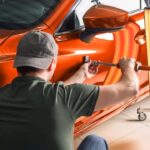Experiencing static, buzzing, or hissing in your car radio, especially on AM stations, after installing a new antenna? A common culprit, particularly in older vehicles or after aftermarket antenna installations, is the noise shield at the splice point of your car antenna cable. This article will guide you through diagnosing and repairing the noise shield on a splice car antenna to restore clear radio reception.
Often, when replacing a car antenna, especially in older models like a classic Lincoln Town Car, the original antenna cable needs to be spliced to connect to the new antenna or an aftermarket radio system. This splice, if not properly shielded, can become a major entry point for radio frequency interference (RFI) and electromagnetic interference (EMI), leading to unwanted noise in your radio.
The noise shield, typically a braided or foil layer surrounding the inner conductor of the coaxial antenna cable, is crucial for preventing these interferences. When splicing antenna cables, it’s vital to maintain the integrity of this shield across the splice. If the shield is compromised, even slightly, it can act like an antenna itself, picking up noise from the car’s electrical system and environment. This is often exacerbated when the engine is running, as the electrical system generates more noise.
To repair the noise shield on a splice, you’ll first need to locate the antenna cable splice. This is usually found near the radio unit or where the old antenna cable was cut. Visually inspect the splice. If it was simply taped with electrical tape, this is a likely area of concern. Electrical tape alone is not sufficient for shielding radio frequencies.
The repair process involves properly reconnecting and shielding the splice. Here’s a step-by-step approach:
- Examine the Splice: Carefully remove any existing tape or covering from the splice to expose the wires. Identify the center conductor and the outer shielding layer of both antenna cables being spliced.
- Ensure Good Conductor Connection: Make sure the center conductors are securely connected. If they are loose or poorly connected, you may need to re-splice them using appropriate butt connectors or by soldering them together for a reliable electrical connection.
- Restore the Noise Shield: This is the most critical step. You need to ensure the shielding of both cables is effectively joined across the splice. There are several methods:
- Coaxial Splice Connectors: These connectors are designed specifically for joining coaxial cables and maintaining shielding. They provide a robust and shielded connection.
- Shielded Butt Connectors: Some butt connectors are designed with shielding in mind. These can be used if you carefully ensure the shielding layers of the cables are in contact with the connector’s shielding.
- Foil Tape and Grounding: Wrap the splice area tightly with conductive foil tape (like copper or aluminum foil tape). Ensure the foil tape makes good contact with the shielding of both cables. For enhanced shielding, you can ground the foil tape to the car’s chassis ground. This helps to drain away any captured noise.
- Secure and Insulate: After restoring the noise shield, wrap the splice with high-quality electrical tape to protect it from moisture and physical damage. Ensure the tape is applied tightly to maintain the integrity of the shielding.
If, after repairing the noise shield at the splice, you still experience noise, consider other potential sources. These could include a poor radio ground, engine noise, or interference from other vehicle electronics. An inline AM/FM antenna noise filter, like the one you considered, can be helpful in reducing persistent noise issues, especially if the source is difficult to pinpoint. These filters work to block unwanted noise frequencies while allowing radio signals to pass through.
Remember, a properly shielded antenna splice is essential for clear radio reception in your car. By focusing on repairing the noise shield, you can often eliminate unwanted static and enjoy your car radio, especially on sensitive AM bands.

